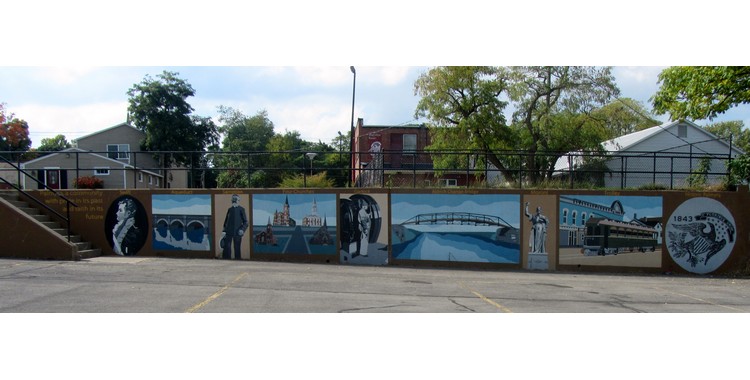Located at 133 Market St., Palmyra NY 14522
It is in a parking lot on the west side of the street across the street from the Palmyra Historical Museum.
Palmyra – a community with pride in its past and faith in its future
This mural depicts significant icons of Palmyra’s past.
John Swift was a resident of Palmyra and a Brigadier General during the war of 1812. He led the charge to take Fort George near present day Niagara-on-the-lake.
Mud Creek Aqueduct was a 94 foot wooden aqueduct that carried canal traffic over Mud Creek when the Erie Canal was originally built. Its remnants still remain.
William T. Sampson was a resident of Palmyra and was a Rear Admiral in the Navy commanded the North Atlantic Squadron during the Spanish American War in 1898. His fleet was responsible for the complete destruction of a Spanish fleet during the Battle of Santiago in Cuba. He also served in the Civil War as part of the South Atlantic Blockading Squadron.
The four corner churches in Palmyra, New York is the only place in the United States with a major church on each corner of a main intersection. Because of the several Religions that started in this town, including Spiritualism and The Church of Jesus Christ of Latter day Saints, the four corner churches seem to be symbolic of the religious diversity of Palmyra. The four corner churches include the First Methodist Church on the northeast corner, the First Baptist Church on the southwest corner, the Palmyra Zion Episcopal Church on the southeast corner, and the Western Presbyterian Church on the northwestern corner. The four corner churches are located on the corners of Main Street and Canandaigua Road right in the center of Palmyra, New York.
Garlock Packing Company was established by Olin J. Garlock in 1887 in Palmyra, New York. Mr. Garlock had developed a seal for the pistons of steam engines that was superior to other seals at the time. His ingenuity led to the creation of Garlock Sealing Technologies. His company grew by providing seals and gaskets to industrial companies all around the United States and is an important part of Palmyra’s economy.
In January 1997, after months of preparation, a dedicated group of volunteers made a dramatic rescue from a farm stream in Macedon, NY. The bridge they saved, the Aldrich Change Bridge, was the only surviving canal change bridge and the oldest cast and wrought-iron vehicular bridge in New York State–and possibly the United States. This unique historic artifact, built in 1858 and located in Rochester before being moved to the Macedon-Palmyra line in 1880, was restored and installed near its original location on the Towpath Trail in Aqueduct Park. Visitors can now walk or bike up and over the bridge in just the same way the mules and horses did over 100 years ago, as they made their way from the south to the north side of the Canal.
On the 22 of September 1823 Joseph Smith, founder of the Church of Jesus Christ of Latter-day Saints, went to the Hill Cumorah for the first time after being told about an ancient record by an angel (Moroni) the night before in his family’s small home. The angel showed him the record but would not allow Joseph to take it until he was spiritually ready. The angel Moroni told him to come back to the very spot where the record lay in the Hill Cumorah the same day the next year. He ended up visiting the hill 4 more times for five years total before the angel Moroni thought Joseph was ready to receive the record. He officially received the record 22 of September 1827 and started translation soon afterward. Joseph Smith translated this record and today we know it as the Book of Mormon. The Hill Cumorah stands today with a statue of the Heavenly Messenger, Moroni on the top commemorating the ancient record that was buried, and preserved for the benefit of the people of our day. A Visitors Center is also located on the site.
In the early 1900s an important means of transportation in Palmyra was the trolley. The trolley scene shows the Rochester Syracuse and Eastern Trolley which connected Palmyra with both Rochester and Syracuse for both passengers and freight.
Artwork by Macedon High School Art Teacher Mrs. Molly Day-Karpovage 2006
And Art students: Samantha Corey, Stacey DeJaegar, Brad Everdyke, John Fielding, Emily Hargrave, Becky Killinger, Jennifer Krolak, Chris McCarthy, Dereck Piccola, Angela Zambito
